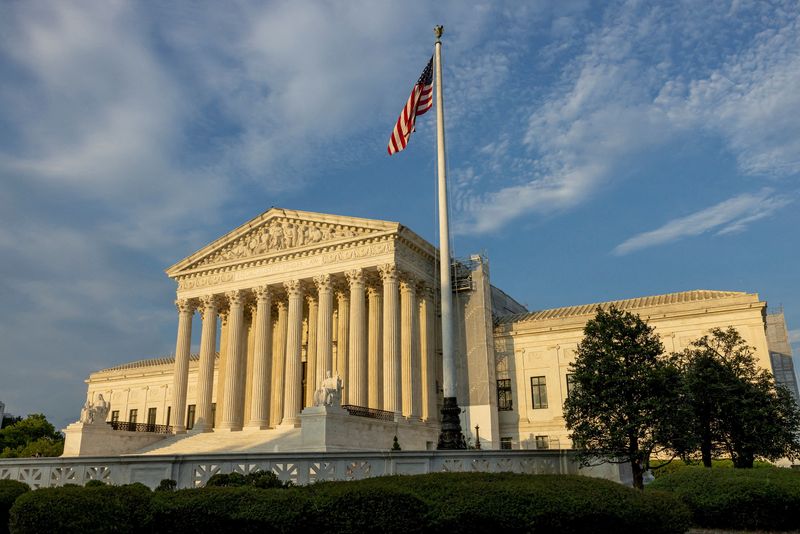WASHINGTON (Reuters) – The U.S. Supreme Court’s divisions deepened over its nine-month term that culminated this week with a ruling powered by its 6-3 conservative majority granting former President Donald Trump substantial criminal immunity for actions taken in office.
A term during which the court constrained the U.S. government’s ability to regulate industry – following recent terms when it rolled back abortion rights, expanded gun rights and rejected race-conscious collegiate admissions – laid bare ideological fractures that mirror a profoundly divided nation.
Those rulings and others have moved American law sharply rightward.
Liberal Justice Sonia Sotomayor accused her conservative colleagues of embracing a dangerous expansion of presidential powers in ruling that Trump, now seeking a return to the White House, is immune from prosecution for some of his efforts to overturn his 2020 election loss, which led to the Jan. 6, 2021 U.S. Capitol attack by his supporters.
Trump is the first former U.S. president to be criminally charged and the first to be convicted. He is now the Republican challenger to Democratic President Joe Biden in the Nov. 5 U.S. election, a rematch from four years ago.
“The relationship between the president and the people he serves has shifted irrevocably,” Sotomayor wrote in a dissent, joined by fellow liberal Justices Elena Kagan and Ketanji Brown Jackson. “In every use of official power, the president is now a king above the law.”
Chief Justice John Roberts, part of the conservative majority strengthened by Trump’s three appointees, in his ruling accused the liberals of “fear mongering on the basis of extreme hypotheticals.”
Harvard Law School professor Mark Tushnet said this term intensified the ideological split on the top U.S. judicial body.
“The division between conservatives and progressives, which existed before this term, seems to me to have hardened a bit, though it’s not completely ossified,” Tushnet said. “The rancor, which again could be seen before this term, seems to me to have gone up a notch.”
PUBLIC OPINION
The court’s standing in public opinion polls has cleaved along partisan lines.
Before the June 2022 decision ending the court’s recognition of a woman’s constitutional right to abortion, a majority of Republicans and Democrats had looked favorably on the court, according to Reuters/Ipsos polling. Since then, Democrats have soured on it while Republican approval has increased.
In December 2021, 57% of respondents – including 57% of Democrats and 55% of Republicans – expressed a favorable view of the court. A poll last month found approval by Democrats down to 22%, with Republican approval rising to 69%. That put overall approval at 41%.
An ongoing push by congressional Democrats for Supreme Court ethics reform made little progress this term even as conservative justices faced fresh scrutiny for actions off the bench. These included revelations that flags associated with Trump’s attempts to overturn the 2020 election flew outside of two of Justice Samuel Alito’s homes, and that Justice Clarence Thomas failed to disclose luxury vacations he had accepted from a billionaire benefactor.
Alito has said it was his wife who flew the flags. Thomas has said he regarded the trips as the kind of personal hospitality regularly exchanged between friends.
‘JUDICIAL HUBRIS’
Another ruling decided along ideological lines dealt a major blow last week to federal regulatory power by overturning a 1984 precedent that had led to a legal doctrine known as “ Chevron (NYSE:CVX) deference” that had called on judges to give deference to federal agencies in interpreting laws they administer.
Kagan said the court had elevated its power over the U.S. government’s two other branches – executive and legislative.
“A rule of judicial humility gives way to a rule of judicial hubris,” Kagan wrote. “In recent years, this court has too often taken for itself decision-making authority Congress assigned to agencies.”
The court’s liberals have expressed their discontent beyond just their written dissents.
“There are days that I’ve come to my office after an announcement of a case and closed my door and cried,” Sotomayor said during remarks in May at Harvard University. “And there are likely to be more.”
The sharp exchanges within the court have not all come along the conservative-liberal divide.
The court ruled 6-3 last month to permit – for now – abortions to be performed in Idaho when pregnant women are facing medical emergencies. But the justices dispensed with the contentious issue without actually deciding the underlying legal dispute.
Alito, Thomas and fellow conservative Neil Gorsuch were the dissenters.
“Apparently, the court has simply lost the will to decide the easy but emotional and highly politicized question that the case presents. That is regrettable,” Alito said.
Jennifer Mascott, a Catholic University law professor, said acrimonious dissents have a long history at the Supreme Court. She pointed to instances this term that “go against the narrative” of the court being ideologically riven or reflexively opposed to the regulatory “administrative state.”
Mascott cited the court’s 7-2 decision, authored by Thomas, that upheld the Consumer Financial Protection Bureau’s funding mechanism, handing a victory to Biden’s administration and a setback to the agency’s conservative critics.
But other legal experts said this term will be remembered for rulings that undermined federal regulatory power and vastly increased presidential powers, with scant support from the court’s liberals.

“In other circumstances, Chief Justice Roberts’s failure to attract even one progressive to his side in the presidential immunity case would be regarded as a serious failure of leadership,” Tushnet said. “His tone in responding to the dissents, which is more heightened than seems to me necessary, might flow in part from that frustration.”
(This story has been refiled to correct the hyperlink in paragraph 1)
To read the full article, Click Here

